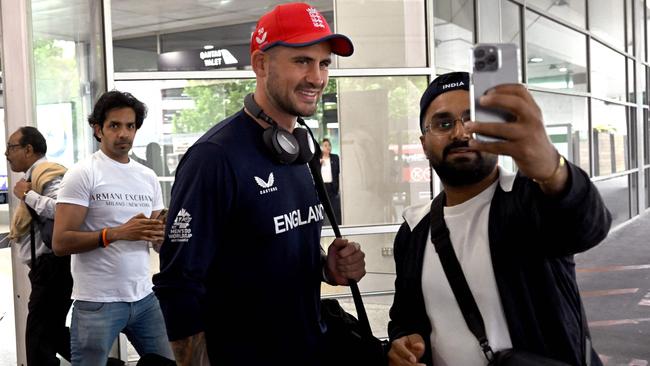
There was no place for Hales in the 2019 tournament, for reasons of his own doing after two failed recreational drug tests. Yet he had played a central role in the resurrection of England’s one-day cricket post-2015. The 33-year-old has now played a vital role in getting them to the final of the T20 World Cup in Melbourne, by playing the very cricket, aggressive and fearless, that began the process of renewal under Morgan.
Hales made a blistering 86 not out in 47 balls against India, sharing in the most belligerent opening stand of the tournament with Jos Buttler, the captain, who finished the match in grand fashion with a scorching six. They put India’s bowlers to the sword and the match was as good as over after the opening powerplay. There was no let-up thereafter, and they left the field arm-in-arm, brothers again.
You would have got long odds on this resurrection, though, in the months before the squad was picked. The selectors seemed to have moved on from Hales. Yet the twist came, first through Morgan’s retirement, then through Jason Roy’s rank loss of form, and finally through the freak golfing accident to Jonny Bairstow. Hales was not a certainty to replace Bairstow but he was the obvious choice, and vindication came in glorious style at the Adelaide Oval when India’s bowlers felt the power of his striking and the ferocity of his intent.
He was the obvious choice not only because of his one-day pedigree but because of his record in Australia during his time in the Big Bash League. Within that competition, he had enjoyed some fine outings at the Adelaide Oval. In 2021, for Sydney Thunder, he hit a century against the Adelaide Strikers. He loves the even pace and bounce of the pitch – who doesn’t? – and the short, square boundaries that are enticing for a player of his power. He hit seven sixes in his 86, as many as India hit in their entire innings.
Finally, this was Hales at his best. Afterwards he reflected on the special relationship he enjoys with Adelaide, and Australia in general. “I think this is one of the best grounds to bat on in the world,” he said. “You get great value for your shots with the short, square boundaries and it is a ground I have good memories at. I never thought I’d play in a World Cup again, and to get a chance is a special feeling. It’s a country I love playing in.”
This was vindication for him and England’s selectors in more ways than one. First, well done to Rob Key, the England managing director of cricket, for taking a call from Hales and listening to the batsman’s argument for why he, Hales, should replace Bairstow, and acting upon it.
Second, to the maturity of the response from England’s senior players, who were prepared to recognise that a functioning team is not necessarily the same as a bunch of best mates.
Third, to Buttler and the coach, Matthew Mott, for retaining faith in Hales through a sticky T20 series in Pakistan and then for retaining the opening partnership in the face of a selection dilemma when Phil Salt was called into the team because of the injury to Dawid Malan.
The signs were there, of course, in the previous two matches. With England’s qualification hanging by a thread after defeat by Ireland and a washout against Australia, the opening partnership between Hales and Buttler had begun to come good: they put on 81 in ten overs against New Zealand and 75 in seven against Sri Lanka.
This annihilation of India’s attack, 170 in 16 overs, topped it off, the best opening partnership of the tournament by far.
It was the intent shown by England’s openers that stood in stark contrast to the way India played. The game was won and lost in the opening powerplay, when India crawled to 38 for lossof one wicket, and England blazed to 63 without loss. It was a contrast that reminded me of England’s semi-final thrashing of Australia in the 50-over World Cup semi-final in 2019, with one team playing a different type of game from the other.
India’s bowlers, and fielders, looked shell-shocked. The normally cool and collected Rohit Sharma could be seen handing out a stern team talk at the halfway mark. No bowler could halt the charge and the fielding crumbled under pressure, with a comical all-run four in the ninth over when an attempted relay throw went awry, and a fumble from Suryakumar Yadav in the 14th over when he dropped a catch and pushed the ball over the boundary. It was at that point that hordes of Indian supporters began to exit the ground. They could take no more.
Defeat will bring an end to an era of India’s T20 cricket. After two World Cups in two years, in which they have been found wanting, it is likely that they will now look to the future and to a new generation of talent waiting in the wings.
England have now set up a mouth-watering meeting with Pakistan on Sunday, a repeat of the 50-over World Cup final of three decades ago. It will present as an intriguing clash of philosophies: the best bowling attack (Pakistan) against the most aggressive and dynamic batting line-up (England).
The battle between a resurgent Shaheen Shah Afridi and England’s openers will play a critical part.
No doubt Hales and Buttler were watching when Shaheen began Pakistan’s semi-final against New Zealand in such dramatic fashion, swinging the new ball at pace.
Little doubt, too, that Shaheen was watching as Buttler and Hales took India’s swing bowlers apart.
If Hales can continue in this vein of form and tame Pakistan’s fine attack, a World Cup winner’s medal awaits him at last. His place in any future conversation would be assured.
The Times




For a long time Alex Hales was in danger of being airbrushed from England’s greatest era of one-day cricket. The three-year gap, filled with acrimony, between his omission from the 50-over World Cup in 2019 and a return to the team threatened to diminish the part he had played in England’s resurgence under Eoin Morgan. On a glorious evening in Adelaide, though, he issued a brutal reminder of his destructive talent.